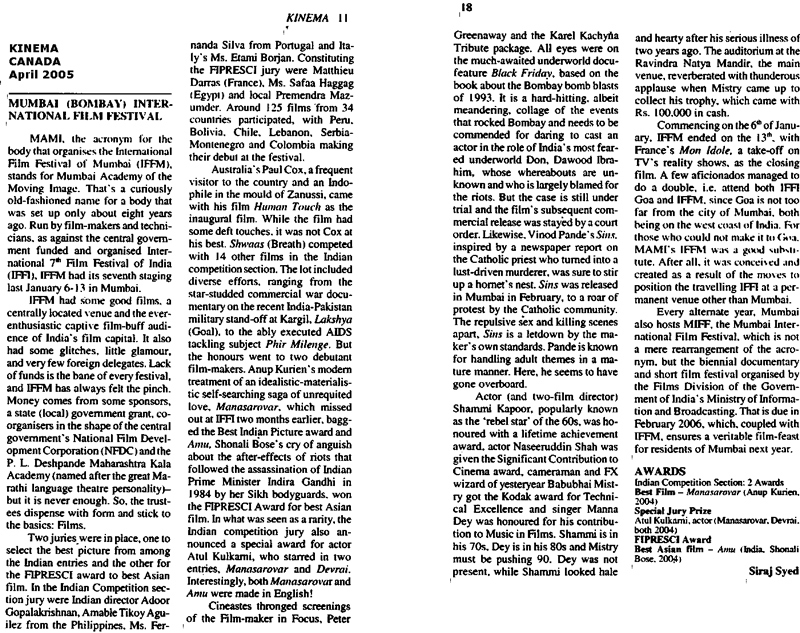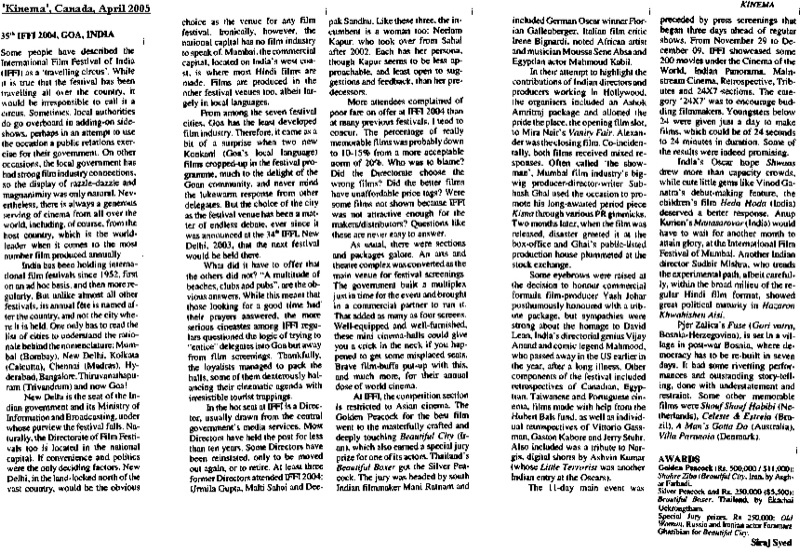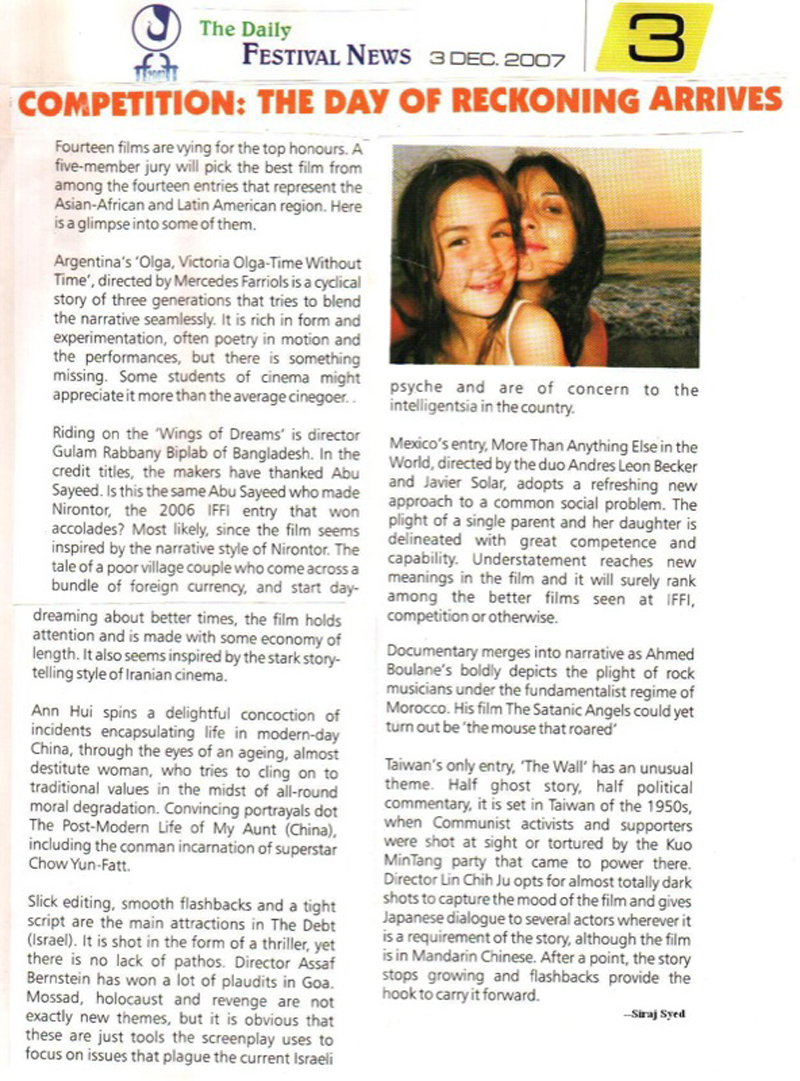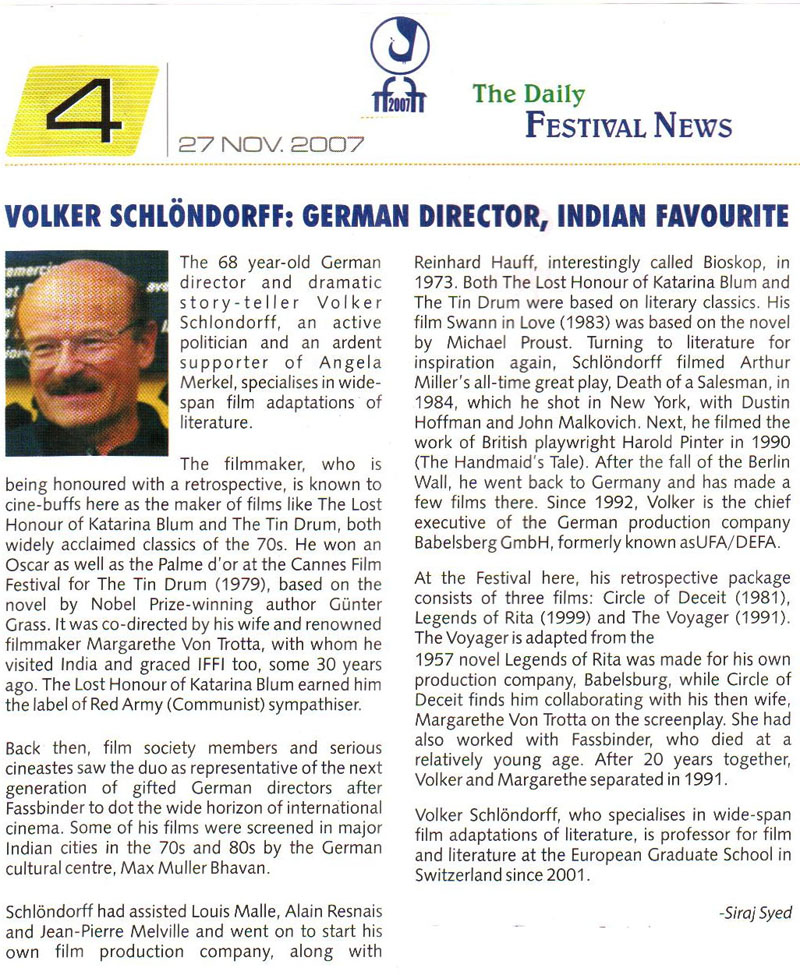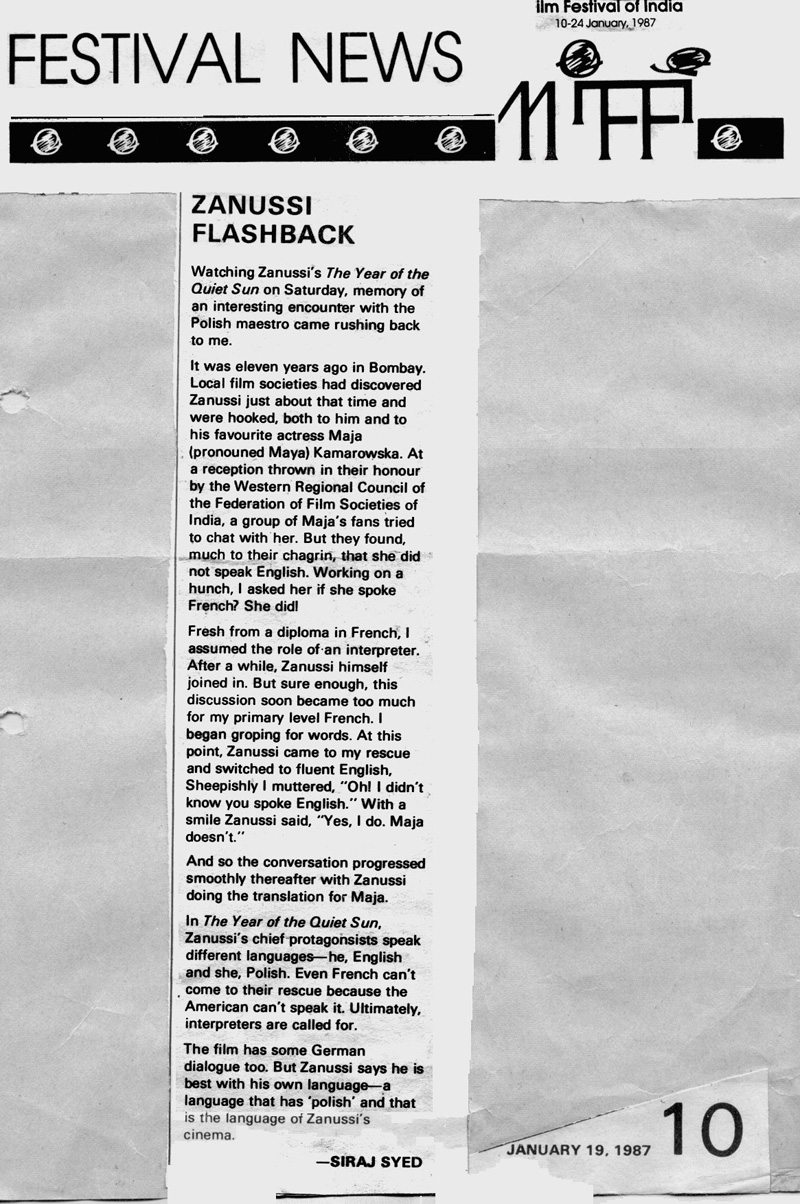|
|
||
|
Pro Tools
FILMFESTIVALS | 24/7 world wide coverageWelcome ! Enjoy the best of both worlds: Film & Festival News, exploring the best of the film festivals community. Launched in 1995, relentlessly connecting films to festivals, documenting and promoting festivals worldwide. We are currently working actively to upgrade this platform, sorry for the inconvenience. For collaboration, editorial contributions, or publicity, please send us an email here. User login |
Siraj SyedSiraj Syed is the India Correspondent for FilmFestivals.com and a member of FIPRESCI, the International Federation of Film Critics. He is a Film Festival Correspondent since 1976, Film-critic since 1969 and a Feature-writer since 1970. He is also an acting and dialogue coach. @SirajHSyed  Bhonsle, Review: Cinema of no escape
A maker with a penchant for addressing social and sociological malaises tries his hand at the intra-nation village/small town to big city trans-migration issue in India, as seen through three different angles, by inhabitants of a Mumbai chawl (shanty/slum). Though Bhonsle is largely realistic cinema, Devashish Makhija, nevertheless, bends his treatment occasionally, to use tropes to move the story forward. The result is an above average film that has enough merit to be watchable on its own, but falls short of the expectations raised by his earlier efforts, which were much more compelling. Bhonsle is a police constable (called havaldaar in India) and today is his last day at work. He is retiring, at the age of 60, the prescribed age. Living alone, and a loner by nature, Bhonsle is obviously not on the take, judging by the frugal, hand-to-mouth existence he leads, living in a shanty and doing all his chores himself. His request for an extension in service is being considered by his superior, Inspector Talpade, who has sounded the higher-ups on the subject, but it is taking time. Also living in the chawl are Vilas, a local politician’s troublemaker, and Rajender, a Bihari (immigrant from the state of Bihar) who wants to maintain his ethnic identity. It is the time of the year when Mumbai-ites celebrate Ganesh Chaturthi, a festival that lasts under two weeks and is marked by worship of the elephant-headed God, Ganesh. After several days of revelry and pooja (worship), the idols are immersed in the sea. Several million devotees observe this feast, mainly in Mumbai and other parts of Maharashtra. Rajender wants Biharis to hold their own Ganesh pooja, while Vilas is strongly against Biharis trying to usurp a Maharashtrian custom. He is already cut-up about their grabbing jobs that should have gone to the locals, but Rajender is adamant. Vilas tries to involve Bhonsle in the matter, but Bhonsle refuses to intervene. A fight ensues, in which Rajender is beaten-up by Vilas, who is later arrested and sent to jail. Into this very shanty move-in a nurse, Sita, and her young son, Lalu, to live, among hostile neighbours. She wears a mangalsutra (a beaded chain worn around the neck by married women). Nothing else is known about her. Rajender befriends her son and forces him to throw black colour at the wall of the chawl’s library, being piqued at the library’s refusal to stock Hindi newspapers, confining the titles to Marathi publications. He confesses to his mother, who takes Bhonsle into confidence. Bhonsle makes him promise that he will not do any such thing again, and that he will clean the sullied wall too. Finding Bhonsle unconscious one day, Sita takes him to hospital, where tests reveal he is suffering from a stage 4 brain tumour. So far, every film that Devashish Makhija has made has been written, or co-written, by him. He’s a poet, a graphic artist and fiction writer too. Beginning his career as a chief assistant director on a formulaic film, Bunty Aur Babli, his sensitivities were probably shaped by his second foray into filmdom, Black Friday (2007), where besides being assistant director, he was also assistant scriptwriter and researcher. In 2008, Doga, based on the comic character, would have been his first script, but Anurag Kashyap never got around to making the film, and dropped the idea altogether in 2018. His first full credit for screenplay and dialogue was a film called Bhoomi (Land), directed by the Bunty aur Babli (Bunty and Babli) cinematographer, Aveek Mukhopdhyay, released in 2009. Devashish turned writer-director with Oonga. Ajji (Granny) was his second feature, Bhonsle being the third. Meanwhile, he has made several short films: Rahim Murge Pe Mat Ro (Don’t Cry for Rahim Cock), El’ayichi, Taandav (Dance of Destruction) and Absent. RMPMR is about a cock that sired 775 offspring before it was slaughtered, and lasts a whopping 57 seconds. Yes, you read that right. 57 seconds. El’ayichi is another bizarre film, set in a highly realistic, present-day milieu, about a ghost who is not really dead and wants to die again. Absent dealt with a man convicted of a terror plot and awaiting his execution, on death row. Agli Baar (Next Time; 2015-16) was inspired by the famous quote that if you do not speak up for other victims now, some day, you might be the ‘other’, and “they” might come to get you. Taandav, made in 2016, brought him close to Manoj Bajpayee, who played a moustachioed cop in it, as he does in Bhonsle, which he went on to produce. Anybody who has been exposed to the oeuvre of Devashish Makhija will know for sure that he does not make escapist cinema. In fact, if anything, his kind of cinema is a cinema of no escape. Many of his characters meet with brutal, gory, even revolting ends. One would have expected his art to evolve with Bhonsle, marking his thirteenth year in filmdom, and either witness him exploring a new idiom, or break-down existing grammatical norms. That has not happened. Three distinct qualities pervade Bhonsle—a love for slowing down all action to almost slo-mo, things taking very, very long to happen and the love for out-of-focus characters, very often in the foreground. While the first two elements of technique lend themselves to logical extensions of style—humdrum routines, loneliness, alienation, waiting endlessly for an extension in service, imminent death due to disease, or just waiting to meet someone, and more—the third reminds us of the European cinema of the 1950s and 60s, which frequently dealt with concentration camps, post war mental trauma and communist purges. Makhija uses the defocussing of the foreground, and/or background, then focussing, a bit too often, thereby losing impact. For the major part, the point is already made, so why drag it on to 126 minutes (in my Vimeo screener version, though one source gives the length as 132 minutes; that might be another version/cut)? And that from a maker who can say so much (far too much) in 57 seconds! He has much longer footage to say much less, in a film lasting over two hours. And mind you, there are no songs to buffer the viewing time. These points are not made to say that what he says is either irrelevant or unimportant. On the contrary, playing within the confines of the country’s censorship policies, he has said a lot. Tolerance is one message that comes across hard and strong. Manipulation of the deprived classes at the grass-roots levels by petty politicians is another. And using the name of a Maratha king of yore, Chhatrapati Shivaji Bhonsle Maharaj, to try and pit a lowly, retired constable, named Bhonsle, against immigrants inhabiting the chawl (quaintly named Churchill Chawl), in order to whip up communal tension against the “outsiders” is another. Showing the protagonist afflicted with a stage 4 brain tumour and the use of rape as a means of revenge and assertion of manly authority are tropes that are crucial to the screenplay. Remove them, and there will be no climax left. Yet, how I hope Devashish had found some other plot points to develop, just like the entire nurse background. You know she has been made a nurse for a reason, but you like the way her persona unfolds. The rape and the follow-up are rather well directed, once you accept that this is the way the narrative is going to lead us on. There are true life militant political parties in Maharashtra who have agitated against immigrants, with the agitation often turning ugly and violent. Makhija has a party in his film too, whipping up similar sentiments. Incidentally, he shares writing credits with Mirat Trivedi (co-writer on Ajji) and Sharanya Rajgopal (Chief writer and Creative Producer at Terribly Tiny Talkies), though dialogues are his solo contribution. In the direction department, his associate is Arun Fulara. Manoj Bajpayee, who was 49 when this film was made, looks that age, in spite of white streaks in his hair and a thick, grey, bushy moustache. Not quite the 60 that he is supposed to be. Only in the climax, he seems to have suddenly aged, and that is okay for a man who is so close to death. With barely 50 words to speak in the entire film, he conveys a lot through his expressions and actions. His trade-mark mannerisms are completely absent, firstly because he has so few lines, and secondly because he is made to speak so softly. This is the kind of film that brings its lead actor awards, and the sequence of encomiums seems to have just begun, with nominations. Just rewards are likely to follow. Ipshita Chakraborty Singh as Sita, the only noticeable female character, with the unknown antecedents, is a complete natural, while Virat Vaibhav as Lalu makes a highly convincing 6-7 year-old. Santosh Juvekar as Vilas Dhavle, Abhishek Banerjee as Rajender, Sunil Jadhav as the militant party trouble-monger Dange, Vishwas Parelkar as the new pawn in the hands of Dange, Rajendra Shisatkar as Inspector Talpade---all perform uniformly well. Good support comes from Kailash Waghmare, Shrikant Mohan Yadav, Sandip V. Pednekar and Chittaranjan Giri. To give them their rightful due, the producers have credited 12 voice artistes as well—those who can be heard, in ambient shots, but not seen. Jismet Wangchuk, the Director of Photography, has shot challenging Ganapati processions in a swelling span reminiscent of the kind of crowd camera work we saw in Black Friday. An unconfirmed report said 70,000 junior artistes were used! Most of Bhonsle is dark and bleak, and the little streaks of yellowish orange play an important role amidst the greys. As mentioned above, there is a preponderance of shots that begin with the foreground/background out of focus, but that could be the director’s call. Hand held is clearly the weapon of choice, and it some of the problems that come with it are taken in its stride. Bhonsle is edited by Shweta Venkat Mathew, who has kept it at a crawling pace overall, but important pieces of information and vital developments are conveyed in a jiffy, as in the brain scan report on the phone, the rape, and the much-awaited extension of Bhonsle’s service, subject to medical clearance—what supreme irony! At least a couple of editing points are unprompted, and rough, unless the footage that was to follow has been excised by the censors. Music serves largely to tug at your heart and jolt your sensitivities. It is great Israj and Taar Shehnai playing by Arshad Khan, if only to make you numb with grief. I cannot recall one happy note: it’s grief and morbidity all the way. A unique instrument, the Shehnai is played at Indian marriages and also at funerals, being the primary tool of film background music, employed to wrench and wring out tears. So also its cousin, the Taar Shehnai. While doing the sub-titles, Devashish, Mirat and Arun have taken complete liberty with the translation. While what is being said in Hindi and Marathi is broadly what you read in English, the constructions are highly symbolic, metaphorical and idiomatic (English). And so, I must say something about the language of the film itself. There is token Marathi spoken time and again, while the actors switch back to Hindi, almost at will. While this might be necessary to make the film accessible to a larger audience (Marathi is a regional language; Hindi is understood by more than half the country), it sounds rather contrived. Bhonsle should go into the CV of Devashish as a degree he obtained with good marks, but did not attain distinction. His basics are still right, though, and serious cinema really needs committed, determined and relentless film-makers of the calibre and bent of mind that we have in Devashish Makhija. So, don’t raise the expectations bar too high when you go to see Bhonsle. Maybe some really distinguished fare is on the anvil, agli baar! Rating: *** Teaser Trailers: https://drive.google.com/file/d/13GEtl62n3Xl3SgkMNpzo_1m6xAPxTAv/view https://drive.google.com/file/d/1p45E2CmqpYNELrW4cW6zxiMgk2cmCap0/view https://drive.google.com/file/d/16MjwSGbkyXjxqxitxCRlefFMiEYF7yxr/view 26.08.2019 | Siraj Syed's blog Cat. : Abhishek Banerjee Absent Agli Baar Ajji Arshad Khan Black Friday Bunty Aur Babli Chaturthi Chittaranjan Giri Devashish Makhija Ganapati Ganesh Ipshita Chakraborty Singh Israj Kailash Waghmare Manoj Bajpayee Oonga Rahim Murge Pe Mat Ro Sandip V. Pednekar Santosh Juvekar Shisatkar Shrikant Mohan Yadav Sunil Jadhav Taandav Taar Shehnai Venkat Mathew Virat Vaibhav Vishwas Parelkar Wangchuk Independent FILM
|
LinksThe Bulletin Board > The Bulletin Board Blog Following News Interview with EFM (Berlin) Director
Interview with IFTA Chairman (AFM)
Interview with Cannes Marche du Film Director
Filmfestivals.com dailies live coverage from > Live from India
Useful links for the indies: > Big files transfer
+ SUBSCRIBE to the weekly Newsletter DealsUser imagesAbout Siraj Syed Syed Siraj Syed Siraj (Siraj Associates) Siraj Syed is a film-critic since 1970 and a Former President of the Freelance Film Journalists' Combine of India.He is the India Correspondent of FilmFestivals.com and a member of FIPRESCI, the international Federation of Film Critics, Munich, GermanySiraj Syed has contributed over 1,015 articles on cinema, international film festivals, conventions, exhibitions, etc., most recently, at IFFI (Goa), MIFF (Mumbai), MFF/MAMI (Mumbai) and CommunicAsia (Singapore). He often edits film festival daily bulletins.He is also an actor and a dubbing artiste. Further, he has been teaching media, acting and dubbing at over 30 institutes in India and Singapore, since 1984.View my profile Send me a message The EditorUser contributions |


















